High throughput platform for confident identification and quantitation of organic explosives
High resolution mass spectrometry analysis workflows using the SCIEX X500R QTOF system
Oscar G. Cabrices1, Xiang He1, Scott Krepich2 and Adrian M. Taylor3
1SCIEX, USA; 2Phenomenex, USA, 3SCIEX, Canada
Introduction
The daily occurrence of explosive materials found in crime scenes or geographical warzones is a rising safety concern for legal authorities around the world. This has led forensic scientists to develop rapid and accurate screening techniques to detect explosive occurrence as part of an investigation.
Traditional analytical methods for detecting explosives frequently involve GC or HPLC based approaches. However, these techniques are often challenging for analytical scientists as they don’t provide the essential throughput and selectivity required to identify key components of a crime scene involving explosive use.
High resolution mass spectrometry offers forensic investigators a greater level of explosive occurrence information (e.g., acquisition of analyte specific MS/MS spectra) leading to increased confidence in compound identification and acquisition of accurate mass information at low analyte concentrations.
In this technical note, the multiple uses of the SCIEX X500R QTOF system for the fast, specific and sensitive analysis of the most common organic explosives encountered in forensic analytical settings are demonstrated.
Figure 1. Obtain ultra-fast and confident organic explosive identification. Extracted Ion Chromatogram (XIC) shows a rapid LC separation (2.5 min) and identification of 14 organic explosives using SWATH acquisition.
Features of SCIEX X500R QTOF system for of explosives
- The X500R QTOF system provides high resolution MS at fast acquisition rates (up to 100 MS/MS per second) to enable the quick identification of organic explosives.
- Easily build and optimize targeted methods (MRMHR workflow) on different analytes using streamlined method optimization features in SCIEX OS software 1.3.
- SWATH acquisition provides the comprehensive detection and quantitation of every detectable compound in a contaminated sample. This increases confidence for the accurate detection of explosives eliminating the risk of missing a critical component in the analysis.
- Industry leading robustness of Turbo V ion source with Twin Sprayer APCI probe for sensitive detection of organic explosives.
Methods
Materials: Organic explosive standards were acquired from Accustandard Inc.(New Haven, CT) and Cambridge Isotope Laboratories (Tewksbury, MA). All standards were serially diluted in acetonitrile for analysis. Table 1 specifies all the analytes evaluated in this study. 13C-2,4,6-trinitrotoluene (13C-TNT) was used as internal standard.
Chromatography: HPLC separation was performed using SCIEX ExionLC AC system with two different separation approaches. A method development gradient separation was performed using a Phenomenex Luna Omega 3 µm Polar C18 column (100 x 3.00 mm) with an LC runtime of 6.5 minutes. An alternate fast gradient method for high throughput sample processing was performed using a Phenomenex 2.5 µm Mercury MS Cartridge Hydro-RP (20 x 0.30 mm) with an LC runtime of 2.5 minutes. Mobile phases used were buffered water and methanol/acetonitrile with appropriate additives. Injection volume for both approaches was 7 mL.
Mass Spectrometry: MS and MS/MS data were collected using Turbo V ion source with Twin Sprayer APCI probe on the benchtop SCIEX X500R QTOF system and the SWATH acquisition and MRMHR workflow modes with the SCIEX OS software 1.3 were used for data acquisition.
Guided MRMHR mode in the SCIEX OS software was used to determine the optimal fragment ions for different target compounds and to optimize the compound dependent parameters for each fragment.
SWATH acquisition workflow consisted of a TOF MS scan with looped MS/MS experiments. The Q1 windows (50 Da each) covering 50-400 m/z were automatically populated by SCIEX OS software 1.3 for a total cycle time of 0.32 sec. Figure 3. displays the data acquisition methods and source conditions.
Figure 2. Apply different analysis workflows for explosives analysis with the SCIEX X500R QTOF system. (Top) MRMHR workflow is a targeted data acquisition mode for analyte quantification. (Bottom) SWATH acquisition is data independent acquisition technique that allows comprehensive detection and quantitation of virtually every detectable compound in a sample.
Table 1. List of the organic explosive compounds analyzed in a single injection using the SCIEX X500R QTOF system.
Figure 3. SCIEX OS software 1.3 provides straightforward acquisition method programming. Mass spectrometry parameters used for the analysis of explosives using SWATH acquisition. Seven 50Da wide Q1 windows covering 50-400m/z were used to collect MS/MS on all detectable species.
Developing a high throughput strategy for accurate mass analysis of organic explosives
The initial compound survey using the long column enabled the separation of all analytes in less than 8 min and allowed for detailed method development. However, analysis speed and resolution are crucial for high throughput and confident identification of explosives, which helps forensic investigators improve their case turnaround times.
Figure 1 shows an extracted ion chromatogram of the 14 explosives analyzed with the short cartridge under 3 minutes. The high resolution and speed of the X500R QTOF system allowed for MS/MS characterization of the explosives analyzed, even with such a fast separation.
Table 1 lists the observed spectral precursor mass and corresponding proposed molecular species, associated mass error (ppm). Most explosives were observed as deprotonated molecular form [M-H]-. A number of adducts and alternative molecular species were also observed. Figure 4 shows XIC chromatograms and TOF MS spectra of the acetate adducts for nitramine explosives (HMX and RDX).
Figure 4. Quickly obtain accurate mass spectral iInformation for reliable identification of organic explosives. Nitramine explosives XIC chromatograms and TOF MS spectra for HMX (Top) and RDX (Bottom) demonstrate the high quality separation achieved on these compounds and the spectral quality underlying. |
High quality MS/MS leads to accurate explosive compound characterization and quantification
SWATH acquisition generates comprehensive and high quality MS/MS spectra for quantitation and identification using spectral library database searching. Figure 5 shows extracted ion chromatograms for Am-DNT and 2,6-DNT. The MS/MS spectra allowed the positive identification of both explosives through spectral library searching.
In addition, to help transition from the familiarity of MRM performed on a triple quadrupole system, the MRMHR Workflow on the SCIEX X500R QTOF system was also evaluated. Here, the accurate mass product ions were used for quantitation, which included common fragment ions such as [NO2]- (m/z 45.9923) particular of nitro-based-explosives
Figure 4 shows calibration curves and XICs obtained for TNT and Tetryl using 13C-TNT as the internal standard for quantitation. Linear dynamic range of the explosives analyzed was evaluated and most analytes showed linearity between 1-1000 µg/L.
Figure 5. Automatic MS/MS library search. XICs of Am-DNT (Top) and 2,6-DNT (Bottom) with MS/MS spectra and library match score.
Figure 6. Good linearity was achieved across the targeted compounds using the MRMHR workflow. Calibration curves for TNT and Tetryl are shown, with linearity between 1-1000 µg/L, as well a few representative XIC traces at different concentration levels.
Conclusions
- The SCIEX X500R QTOF system provides the speed and mass accuracy for the high throughput identification and quantitation of organic explosives in forensic analytical settings.
- SWATH acquisition generates comprehensive and high--quality MS/MS spectra, enabling reliable fragmentation for accurate explosive compound identification through spectral library search.
- MRMHR workflow enables sensitive quantitation of organic explosives utilizing selective high resolution accurate mass MS/MS information.
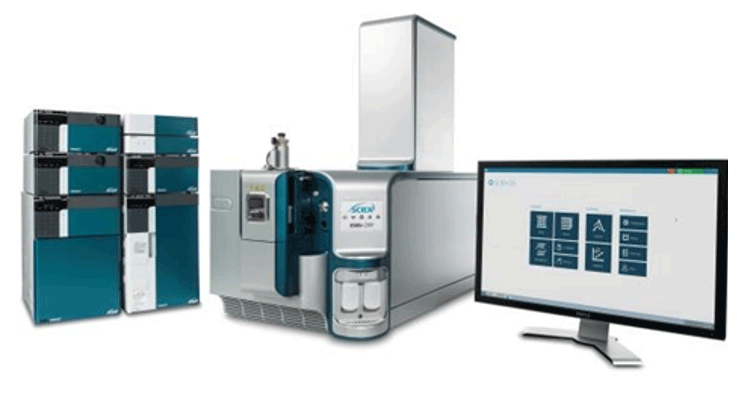
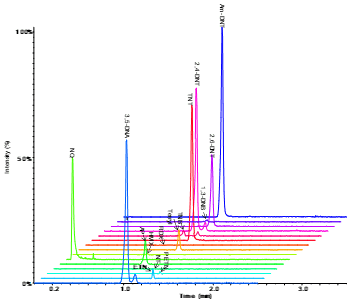 Click to enlarge
Click to enlarge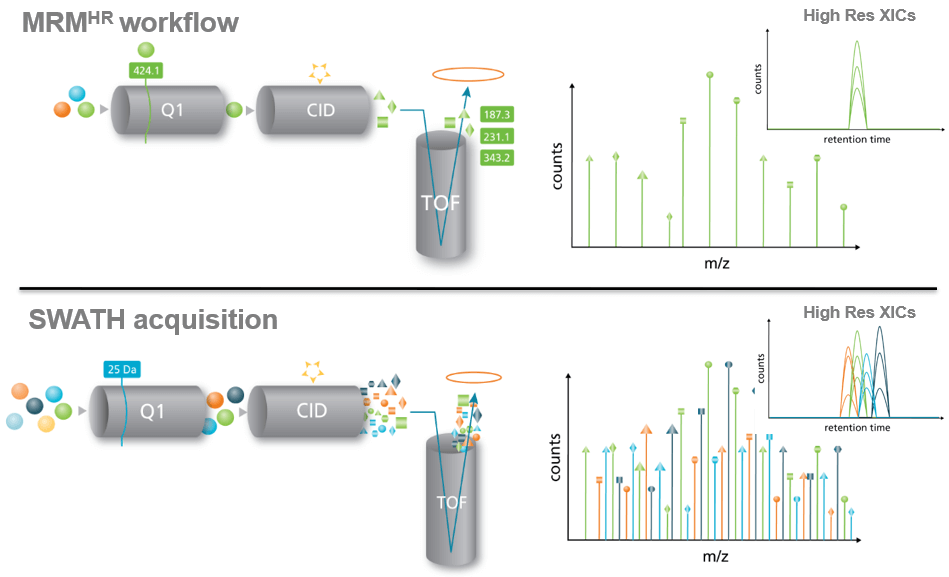 Click to enlarge
Click to enlarge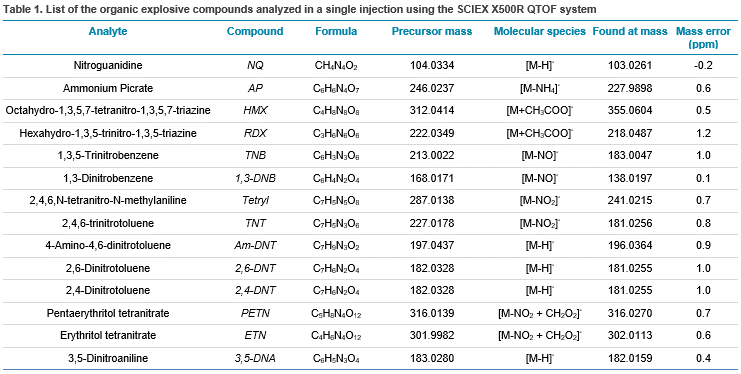 Click to enlarge
Click to enlarge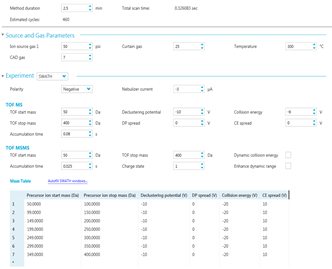 Click to enlarge
Click to enlarge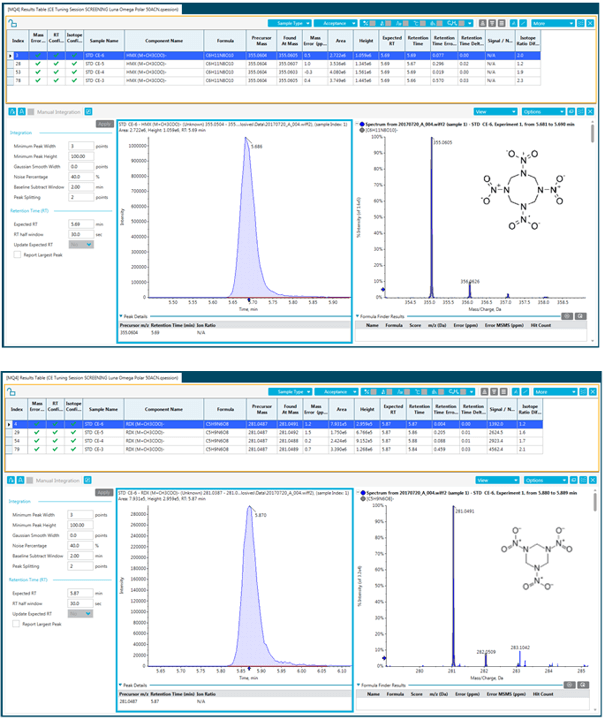 Click to enlarge
Click to enlarge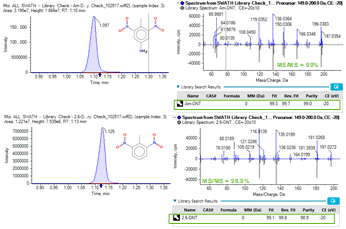 Click to enlarge
Click to enlarge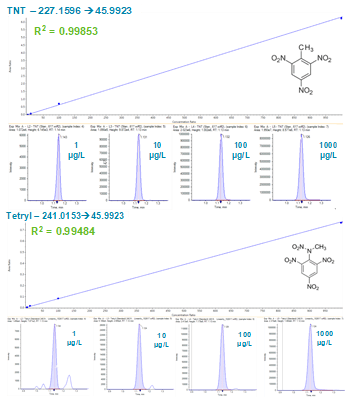 Click to enlarge
Click to enlarge